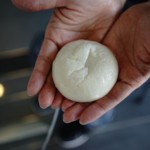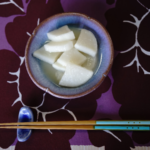【47 Hakko Yamaguchi】山口のあまぎゃあ Amagya 〜山の村のささやかなお楽しみ もち米を使った甘いお粥〜
山の村のささやかなお楽しみ もち米を使った甘いお粥
山陰の古都、萩近くの佐々並に伝わる甘酒の一種。麹と米を水に溶かして温め、麹菌の糖化酵素によって甘粥(地元の発音ではあまぎゃあ)をつくる。変わっているのはもち米を使うこと。佐々並は小さな集落ながら毛利氏の大名行列の通る宿場町として賑わった。村人は藩の目の届かない山の中に棚田を拓き、そこで育てたもち米を麹と混ぜて甘味の強い粥をつくっていたという話も。年貢に適さないもち米は、庶民にとっては役立つものだった。そんな日本の稲作のアナザーストーリーを垣間見せてくれる文化だ。
Sweet porridge made of glutinous rice served as a light refreshment in the mountain village
Near Hagi, the city that flourished as the urban center of the San-in region in the olden days, is a village named Sasanami where this unique type of amazake was invented and cherished to this day. Mixing koji, rice (glutinous rice) and water, and heating the mixture for a few hours promotes the enzymatic saccharification of koji-kin and sweetens the resulting porridge. While the general term for sweet porridge in Japanese is amagayu, it is locally pronounced as amagya in this area. Sasanami was a small village that once flourished as a post town for the warlord procession of the Mouri family. The residents of this village cultivated rice paddies deep in the mountains where the officials of the clan could not notice. The glutinous rice harvested from these paddies was mixed with koji to create this sweet porridge. Since glutinous rice was not considered valuable enough to offer as a local present to the warlord, it became a useful source of daily food for the commoners. This is an anecdote that sheds light on another side of the long history of Japan developing its food culture as a rice-growing nation.
どう作って食べるか / HOW TO MAKE & EAT
❶麹と米(もち米)と水を混ぜ、50〜60度で数時間保温する。
❶Sweet porridge made of glutinous rice served as a Mix koji, rice (glutinous rice) and water, and heat the mixture to 50-60°C for a few hours
おやつとして
As a snack
▶食べられている地域 / Regions where it is eaten
佐々並一帯
Around Sasanami
▶微生物の種類 / Types of microorganisms
麹菌
Koji-kin



